
Vitamin D and bright lights really do work for seasonal affective disorder The official beginning of winter that arrived on Sunday, Dec. 21, marked the darkest day of the year. Around this time, some of us feel a familiar pall as the gloom outside seems to creep into our psyches. Symptoms of depression that occur during the late fall and winter are known as seasonal affective disorder, or SAD. People who live in places with long winter nights are at particularly high risk for this malady. But there are ways to combat the suffering. Bright Light Therapy Therapy with a special high-intensity lamp has been proven to make a difference in brain chemistry, though scientists don’t know exactly why that happens, according to the American Psychiatric Association (APA). “There’s been plenty of research to back that up,” said Sue Abderholden, executive director of the Minnesota branch of the National Alliance on Mental Illness. For bright light therapy to work, you will need between 30 and 90 minutes of exposure to it each day, according to the APA. Your doctor can give you instructions. One method is to sit about two feet from the light with your eyes open, but without looking directly at the lamp. Early mornings, when the therapy can simulate sunrise, may be best. A Minneapolis man said he takes his light therapy lamp out of the basement each year in early- to mid-October. “I know it’s coming, that dark period,” said Lee, 60, who asked to be identified only by his first name to avoid the stigma associated with depression. He uses the lamp for about a half-hour each morning, while reading the paper and eating breakfast. “If I don’t use it for two, three, four...



